So i copied this from a bus of the future blog, looks really interesting. Take a look at the renderings below.
Big Blue Bus Hits the Road!
Hello, Futurists - No sooner have we returned from debuting Bus of the Future designs at the AltCar and APTA Expos then we are hitting the road again. This time the exhibit will be showcased at the California Transit Association Expo in Monterey. So far, it's received great media coverage and accolades from transit industry leaders...check it out:
Santa Monica Daily Press cover story
The Argonaut
KCRW's Design & Architecture blog
LA Times blog
Bus World magazine
Quotes from transit industry leaders:
“Clear Volume” Bus
Santa Monica Daily Press cover story
The Argonaut
KCRW's Design & Architecture blog
LA Times blog
Bus World magazine
Quotes from transit industry leaders:
“Clear Volume” Bus
- The high seating capacity, the attention given to special needs riders and the vertical seating concept create an attractive transportation experience solving many transit woes.
- The design is modern and attractive, yet familiar, making it very approachable for new transit users.
- The very efficient use of sunlight and natural elements will keep the costs of operation very low. Zero-emissions will keep the air clean and breathable.
- The Clear Volume design with center lowering section and vertical seating is very rider friendly and enhances the riders feeling of space while within an enclosed environment.
- When one passenger cell has worn beyond repair, it can be replaced with a new one, as opposed to replacing the entire bus. This will save money and resources across the board.
- The modular design of this bus is exciting and optimizes ridership comfort depending upon conditions present.
- With the varying cells that can be used to match the needs of the riders, this bus should increase ridership immensely and leave no one stranded.
- Powering the bus through a battery system and regenerative braking would work extremely well in a transit setting.
- By running clean and filtering the air while it is operating, this bus will prevent more damage while also reversing the damage from other vehicles nearby. If an entire fleet is introduced, the impact will be substantial.
- Hub mounted electric motors and solar cells are excellent ideas to power this bus.
- Going beyond energy-efficient at the motorization level is now an imperative and it will be even more important by 2050.
- Riders will love the ability to sit on the upper deck and enjoy the scenes of Santa Monica.
Icon Bus render_above
Friday's presentation of the project at Alt Car was an amazing experience. It was an overwhelming opportunity to meet the judges, members of the public who have been following and contributing to the blog, and to present and discuss the ideas about the Bus of the Future. Thank you to all who attended and have contributed to the project.
Icon Bus Main_render
I set out to design a bus that transforms the currently pleasant and convenient ridership experience into a desirable daily occasion. Big Blue Bus’s renowned dedication to community, cleanliness, and friendly convenience serves as the primary inspiration for my designs.
I wanted to effectively make riding the bus akin to spending a day at the beach. I go to Santa Monica to enjoy the ocean, clear my head of stress and reinvigorate my spirits. I thought these motives would be a great starting point to shape my design. Digging a bit further, I though of the whole ‘Seeing and Being Seen” aspect of the beach experience. Whether it’s enjoying the sea with friends and loved ones, or strolling down the Third St. Promenade amongst complete strangers, being a part of the scene is fun and desirable. I wanted to create an iconic design that people wanted to be seen in, to ride in and experience.
I wanted to effectively make riding the bus akin to spending a day at the beach. I go to Santa Monica to enjoy the ocean, clear my head of stress and reinvigorate my spirits. I thought these motives would be a great starting point to shape my design. Digging a bit further, I though of the whole ‘Seeing and Being Seen” aspect of the beach experience. Whether it’s enjoying the sea with friends and loved ones, or strolling down the Third St. Promenade amongst complete strangers, being a part of the scene is fun and desirable. I wanted to create an iconic design that people wanted to be seen in, to ride in and experience.
Icon Bus side_rendering
PEV- POSITIVE EMISSIONS VEHICLE
Exterior TiOx gills break down atmospheric ozone into oxygen, therefore cleaning surrounding air
Shell made from composites derived from CO2 sequestered from the atmosphere
Hub-mounted electric motors powered by Lithium ion batteries, Ultracapacitors quick-charged at each bus stop, and small IC generator for long-distance/ emergency jaunts
Roof-mounted solar cells provide energy for the lighting and climate control systems
ECO-FRIENDLY CLIMATE CONTROL SYSTEM
Inspired by the Kansai Airport HVAC system, Tensile air ducts circulate filtered air around the cabins, efficiently maintaining a pleasant climate
Revolving doors reduce energy required to keep cabin at a constant temperature by minimizing amount cooled air escape at each stop
Roof-mounted chameleon panels change from white to black, depending on whether heat energy needs to be absorbed or reflected to regulate interior temperature
Exterior TiOx gills break down atmospheric ozone into oxygen, therefore cleaning surrounding air
Shell made from composites derived from CO2 sequestered from the atmosphere
Hub-mounted electric motors powered by Lithium ion batteries, Ultracapacitors quick-charged at each bus stop, and small IC generator for long-distance/ emergency jaunts
Roof-mounted solar cells provide energy for the lighting and climate control systems
ECO-FRIENDLY CLIMATE CONTROL SYSTEM
Inspired by the Kansai Airport HVAC system, Tensile air ducts circulate filtered air around the cabins, efficiently maintaining a pleasant climate
Revolving doors reduce energy required to keep cabin at a constant temperature by minimizing amount cooled air escape at each stop
Roof-mounted chameleon panels change from white to black, depending on whether heat energy needs to be absorbed or reflected to regulate interior temperature
Cougar - Final Renderings
The Cougar Concept design is complete and the following renderings show how the many ideas, suggestions, and comments have been brought together in a final design.
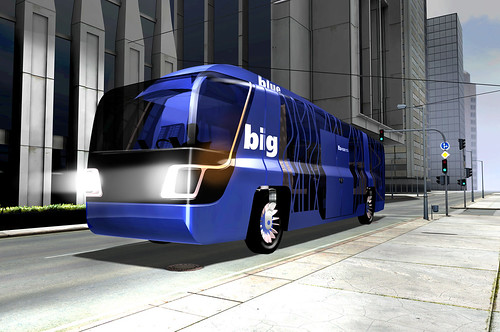
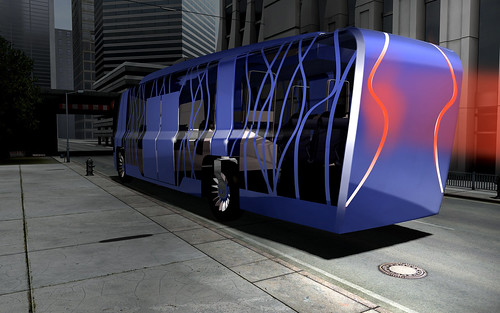

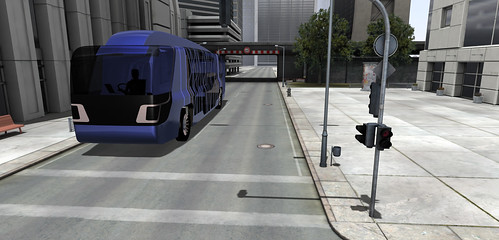
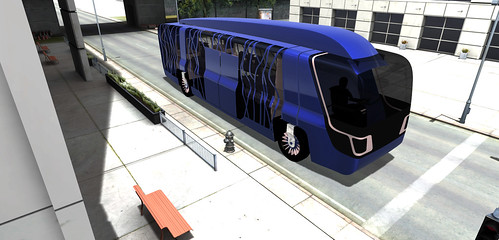
The list below shows the many attributes that ultimately shaped the design of this bus of the future.
Ridership
Innovation
Sustainability
Brand





The list below shows the many attributes that ultimately shaped the design of this bus of the future.
Ridership
- Multiple possibilities for configuring different, unique environments.
- More space for peak time ridership
- More comfort and uniqueness for off peak ridership
- Possibility of creating mobile public expression spaces
Innovation
- Special stand up space saver seating
- Ability to separate passenger cells from motive chassis
- Driver passenger interface which allows access to driver and route info
- RFID prepayment system allows for faster loading of passengers (not unique to this design but part of its motivation)
- In wheel electric motors
- Total drive by wire
Sustainability
- Efficient use of energy
- More effective management of available resources
- Less expense incurred in turnover from old passenger cells to new
- Faster maintenance time due to easier access to mechanical components
Brand
- Worldwide first attempt to separate bus structure into two components.
- Iconic shape of bus chassis and cells will result in memorable affection on the part of ridership and consequent recognition as an ICON.
Functionality - Cougar's Passenger Cell Transfer
The following stills are from an animation created to show the major innovation of the Cougar bus design. The backbone design of the bus frame allows the same chassis to hold a variety of passenger cells throughout the course of any day. The following images show how the passenger cell transfer would work.

Step 1: The bus must be at a complete stop before the passenger cell exchange begins.
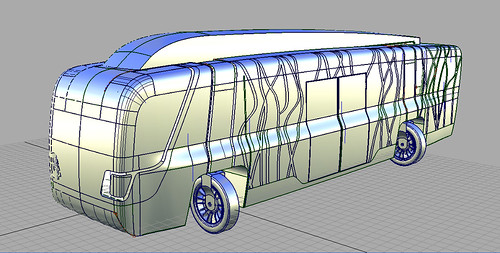
Step 2: The wheels of the bus turn 90 degrees. The “legs” of the chassis move outward until they are no longer touching the bus.
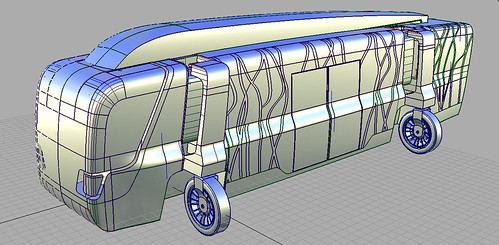
Step 3: The “legs” of the chassis extend vertically lifting the chassis above the passenger cell. The wheels rotate back into the original position for forward motion.
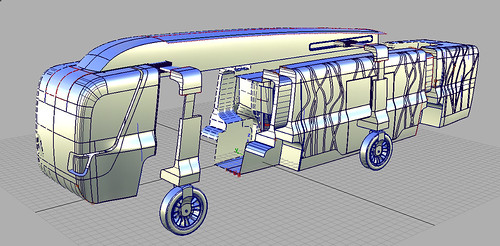
Step 5: The chassis drives forward and leaves the current passenger cell behind. Now the rest of the bus can be serviced more efficiently. Later, a new passenger cell of any length can be reinserted into the chassis.

Step 1: The bus must be at a complete stop before the passenger cell exchange begins.

Step 2: The wheels of the bus turn 90 degrees. The “legs” of the chassis move outward until they are no longer touching the bus.

Step 3: The “legs” of the chassis extend vertically lifting the chassis above the passenger cell. The wheels rotate back into the original position for forward motion.

Step 5: The chassis drives forward and leaves the current passenger cell behind. Now the rest of the bus can be serviced more efficiently. Later, a new passenger cell of any length can be reinserted into the chassis.
8.06.2008
Crunching the Numbers
Hello from the design team! We thought you might be interested in what we're currently doing. Our three future bus designs are finalized and we are now translating our sketches and diagrams into 3d computer modeling software (we use Maya and Alias). Below are a few examples of what this editing process looks like. It's a little scary looking now, but will turn out great!











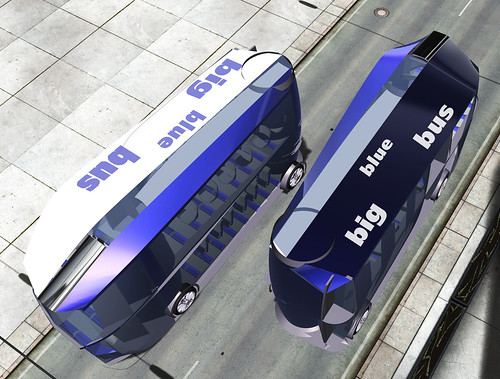

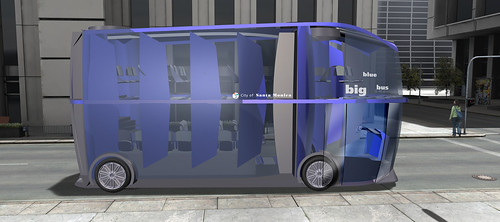
No comments:
Post a Comment